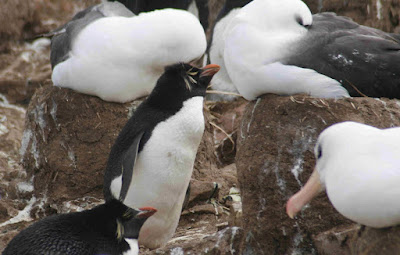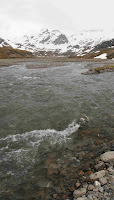
The morning landing is on the privately owned Carcass Island. (It was named after Lord and Lady Carcass. If I remember what one of the naturalists said correctly, they provided some funding for a 18th century research and survey expedition. What a bad name to be stuck with. It is owned by a sheep ranching family. But int he last few years, the bottom has fallen out of the wool industry (it can now cost more to sheer a sheep than you can get for the wool). The family now makes their living from landing fees for tourists (paid for by Lindblad). They have three things that get cruises to stop at their island--one really cool and two that are kind of just nice additions:

- The most important reason is that the island has surprisingly remained rat-free. This means that it still has a great population of the many ground nesting birds--especially the song-bird varieties. It’s kind of surprising that the island has remained rat free because the family doesn’t require cruse ships to take any special precautions when landing. For some reason, for all the years that sheep, feed and supplies has been landed on the island, no rats have been hitchhikers. The birding on this island is amazing!
- They’ve built a large restroom facility. This is the first place we’ve visited (other than Port Stanley) that has had restroom facilities.
- They serve tea, biscuits (cookies) and cakes to the people who land. The variety of cookies is amazing.

One plentiful bird was the a local thrush that looks had behaves exactly like the North American robin (at least a faded robin--no red breast). It is in fact very closely related.
That afternoon, we visit New Island, the western most of the Falkland Islands. Again, a privately owned island, much of it was used for grazing sheep--the tussuc grass has been replaced by a European grazing grass.

We land in a sheltered natural harbor and then hike across a narrow point to the northwestern side. On the hike, we see numerous kelp and upland geese. They have thrived since the sheep were removed--the love the grassy areas. The area we hiked to had been fenced off while sheep were here (to keep them from falling off a high cliff into the ocean.so there is still plenty of tussuc grass. The area below the clifts and along the edge are filled with nesting black browed albatross, Blue-eyed shags (a cormorant) and rock-hopper penguins. We hang out there for over two hours. Lots of “pixels are burned.”

The rock-hopper penguins are the smallest penguin--only about 16 inches tall and are related to the macaroni penguin. They seem to be able to hop up about 12 inches and down about 18 inches. It is amazing watching them move around. They are the first penguin we see that makes a more traditional nest--out of mud, grass and guano.
The albatross makes a rather high pedestal nest out of mud, grass and guano. There seem to be the clumsiest birds when landing--most times falling over in the process. To take off, they walk to the edge of the cliff, wait for a gust of wind and jump.
The blue-eyed cormorants have amazing blue eyes a beautiful blue-black feathers and bright orange tufts of feathers around their beak.

The Lindblad staff managed to make the last day on-shore a great climax.
























